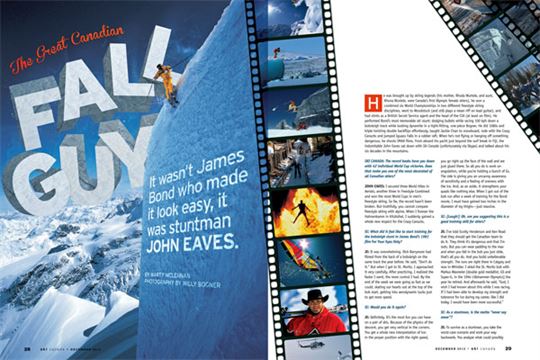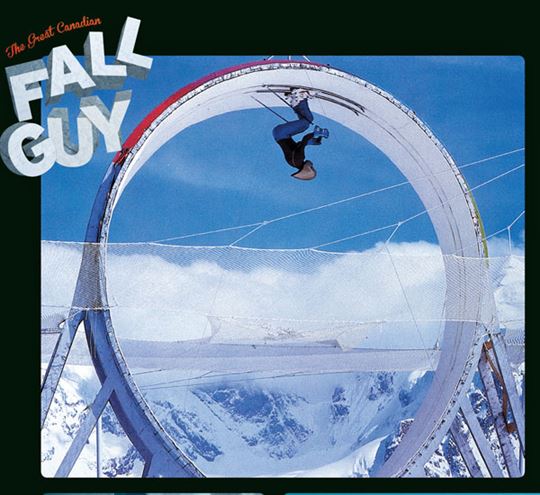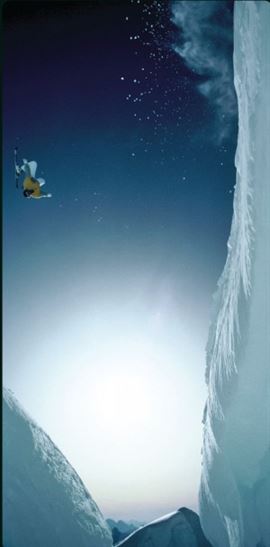It wasn’t James Bond who made it look easy, it was stuntman JOHN EAVES
by Marty McLennan in December 2012 issue

He was brought up by skiing legends (his mother, Rhoda Wurtele, and aunt, Rhona Wurtele, were Canada’s first Olympic female skiers), he won a combined six World Championships in two different freestyle skiing disciplines, went to Woodstock (and still plays a mean riff on lead guitar), and had stints as a British Secret Service agent and the head of the CIA (at least on film). He performed Bond’s most memorable ski stunt: dodging bullets while racing 100 kph down a bobsleigh track while looking dynamite in a tight-fitting, one-piece Bogner. He did 1080s and triple twisting double backflips effortlessly, taught Jackie Chan to snowboard, rode with the Crazy Canucks and jumped Iguazu Falls in a rubber raft. When he’s not flying or hanging off something dangerous, he shoots IMAX films. From aboard his yacht just beyond the surf break in Fiji, the indomitable John Eaves sat down with Ski Canada (unfortunately via Skype) and talked about his six decades in the mountains.
SKI CANADA: The record books have you down with 42 individual World Cup victories. Does that make you one of the most decorated of all Canadian skiers?
JOHN EAVES: I secured three World titles in Aerials, another three in Freestyle Combined and won the most World Cups in men’s freestyle skiing. So far, the record hasn’t been broken. But truthfully, you cannot compare freestyle skiing with alpine. When I foreran the Hahnenkamm in Kitzbühel, I suddenly gained a whole new respect for the Crazy Canucks.
SC: What did it feel like to start training for the bobsleigh stunt in James Bond’s 1981 film For Your Eyes Only?
JE: It was overwhelming. Dick Barrymore had filmed from the back of a bobsleigh on the same track the year before. He said, “Don’t do it.” But when I got to St. Moritz, I approached it very carefully. After practicing, I realized the faster I went, the more control I had. By the end of the week we were going as fast as we could, skating our hearts out at the top of the bob start, getting into aerodynamic tucks just to get more speed.
SC: Would you do it again?
JE: Definitely. It’s the most fun you can have on a pair of skis. Because of the physics of the descent, you get very vertical in the corners. You get a whole new interpretation of ice: in the proper position with the right speed, you go right up the face of the wall and are just glued there. So all you do is work on angulation, while you’re holding a bunch of Gs. The side is giving you an uncanny awareness of sensitivity and a feeling of oneness with the ice. And, as an aside, it strengthens your quads like nothing else. When I got out of the bob run after a week of training for the Bond movie, I must have gained two inches in the diameter of my thighs—just massive.
SC: [Laugh!] Oh, are you suggesting this is a good training skill for skiers?
JE: I’ve told Scotty Henderson and Ken Read that they should get the Canadian team to do it. They think it’s dangerous and that I’m nuts. But you can wear padding to the max and when you fall in the bob you just slide, that’s all you do. And you build unbelievable strength. The runs are right there in Calgary and now in Whistler. I skied the St. Moritz bob with Markus Wasmeier [double gold medallist, GS and Super-G, in the 1994 Lillehammer Olympics] the year he retired. And afterwards he said, “God, I wish I had known about this while I was racing. If I had been able to develop my strength and tolerance for ice during my career, like I did today, I would have been more successful.”

SC: As a stuntman, is the motto “never say never”?
JE: To survive as a stuntman, you take the worst-case scenario and work your way backwards. You analyze what could possibly go wrong and make an assessment, like an insurance adjuster. If you can eliminate most of the danger, and you can pull it off because you have the skill and you’re with the right people—a team you trust—then you do it. It’s a calculated thing. I’ve turned down stunts that were just too crazy.
SC: Any advice for an up-and-coming stuntman?
JE: It’s a rare breed, you know. With computer graphics, a lot of this stuff is manipulated digitally now. But I say if you can land the job and do it safely, go for it.
SC: How many broken bones?
JE: Neck—and nose three times. That’s it.
SC: You’ve always been an innovator in both skiing and the development of skis [Eaves developed the Olin Mark IV mogul ski]. Can you look into your crystal ball and let us know what’s next?
JE: The real breakthroughs are going to come for beginner and intermediate skiers. Somebody is going to invent a ski material that will do anything you want, in the sense that it’ll be loose if you want it to be loose, stiffen up, bend, whatever you want. It will make the sport so much easier.
SC: Scot Schmidt said how difficult it was to make a living doing the Warren Miller thing.
JE: It was a way better experience doing stunts. Bogner made 35mm films that went to cinemas. It was a much more lucrative and grandiose experience in Europe. But that didn’t translate to North America.
SC: I’ve seen you in Bogner’s and Barrymore’s reels. Did you ever ski with Miller?
JE: No, almost did as a cameraman once. It was really with Willy Bogner that I got my start. He was the most powerful influence on my life. He took an interest in me and nurtured my talent for his films. He inspired me with his creativity. It was a wonderful relationship.

SC: At the end of all your films, you always get the girl. Endulge us, who was the best on-screen kisser?
JE: Hmm…Suzy Chaffee…yeah, definitely Suzy [three-time freestyle skiing champion, Eaves’s co-star in Willy Bogner’s classic Fire and Ice and, perhaps not incidentally, ChapStick’s celebrity endorser at the time].
SC: Speaking of films, any suggestions?
JE: All.I.Can. It’s a fabulous ski movie by the Sherpas that has a theme and a message. There is an underlying philosophy that they present about the freedom of being associated with this type of skiing. It’s not just about hucking cliffs. It’s about friends who go out and live in the wilderness, and camp out, and go on incredible journeys together. Then they huck cliffs. [laughs] All.I.Can is the new era in ski filmmaking. You’ve got young kids who are intelligent and creative and present their ideas with artistic interpretation.
SC: Which was tougher: World Cup skiing or stunts?
JE: I never risked my life on tour, but I did as a stuntman.
SC: You were the personal stunt double for Leslie Nielsen for three years. Tell us about it.
JE: He was a riot. He taught the film crew the art of the fart machine. [laughs] He was the master at that and we were his students. On a more serious note, I ended up doing a lot of stunts that were absolutely frickin’ life-threatening.
I jumped out of a helicopter 100 feet over the Fraser once, wearing a wedding dress that went right into my face as I fell into the river.
SC: Like what?
JE: I jumped out of a helicopter 100 feet over the Fraser once, wearing a wedding dress that went right into my face as I fell into the river. But in general, working as a stuntman paid well and was fun. I was young and had a knack for it.
SC: What was the craziest stunt you ever pulled?
JE: In the film Mr. Magoo, I rode over the edge of IguazuFalls on the Brazilian-Argentinean border in a specially rigged life raft. I had to flip the inflatable as I went over the falls—a bigger drop thanNiagara! I was tethered from a helicopter. If that wire had broken, I was a dead man.
SC: What has skiing meant for you?
JE: I feel like I’m at home when I’m on skis. But I also love the smell of burning fires and watching the snow come down and being in some exotic location knowing that there is some incredible skiing to be had. I’m equally thrilled arcing pure GS turns at my home ski area, Nakiska, on its Olympic GS and Slalom runs. I love the technical stuff, I love powder and I love the backcountry. I can’t get enough. I’ve had a life of adventure. I’m still a skier at heart and can’t wait to get back to Canada for the winter season.
SC: Your 60th birthday is coming up. Anything planned?
JE: I’m looking to huck my meat 60 feet on my birthday. No promises, though.
SC: What’s on your bucket list?
JE: I’ve always wanted to be a ski bum. I almost did it one year, but my talent and drive to succeed always got in the way. I was always doing something, working or filming or competing. But at the same time I was always jealous of all those who just lived to ski. I want to know what it’s like to wake up and my only question is something like: What line am I going to ski? Or who am I going to ski with? Or what skis am I riding? I think the place to do it is the Kootenays—and I think I deserve it.




